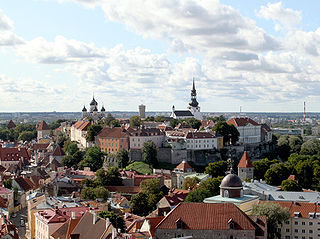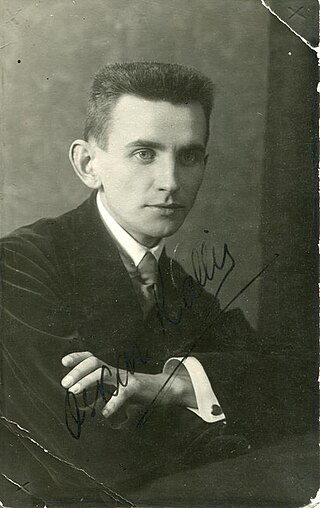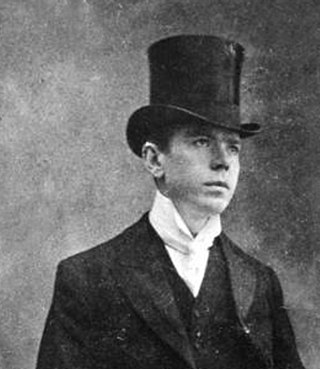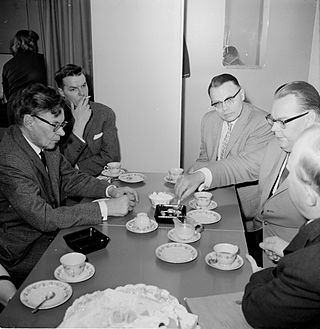
Kalevipoeg is a 19th-century epic poem by Friedrich Reinhold Kreutzwald which has since been considered the Estonian national epic.

Toompea is a limestone hill in the central part of the city of Tallinn, the capital of Estonia. The hill is an oblong tableland, which measures about 400 by 250 metres, has an area of 7 hectares and is about 20–30 metres higher than the surrounding areas. In folklore the hill is known as the tumulus mound over the grave of Kalev, erected in his memory by his grieving wife.

Kambja is a small borough in Tartu County, Estonia. It is the administrative centre of Kambja Parish.
Estonian mythology is a complex of myths belonging to the Estonian folk heritage and literary mythology. Information about the pre-Christian and medieval Estonian mythology is scattered in historical chronicles, travellers' accounts and in ecclesiastical registers. Systematic recordings of Estonian folklore started in the 19th century. Pre-Christian Estonian deities may have included a god known as Jumal or Taevataat in Estonian, corresponding to Jumala in Finnish, and Jumo in Mari.
Like any other medieval city, Tallinn has inspired many legends.

Võru is a town and a municipality in south-eastern Estonia. It is the capital of Võru County and the centre of Võru Parish.

Kristjan Raud was an Estonian symbolist painter and illustrator who was one of the founders of the Estonian National Museum. Folklore elements figure heavily in his subject matter and his style is reminiscent of Primitivism. His twin brother, Paul, also became a well-known painter.

Nõmme is one of the eight administrative districts of Tallinn, the capital of Estonia. It has a population of 39,422 and covers an area of 28 km2 (11 sq mi), population density is 1,407.9/km2 (3,647/sq mi). The district is largely a middle-class suburban area, mostly consisting of listed private homes from the 1920s and 1930s and is sometimes referred to as the "Forest Town."
Kaleva – also known as Kalevi or Kalev – and his sons are important heroic figures in Estonian, Finnish and Karelian mythology. In the Finnish epic the Kalevala, he is an ancient Finnish ruler. In Estonian mythology and Friedrich Reinhold Kreutzwald's epic poem Kalevipoeg, King Kalev was the father of King Kalevipoeg and the husband of Linda.

Estonian literature is literature written in the Estonian language Estonia leads the world in book ownership, on average Estonians own 218 books per house, and 35% own 350 books or more.

The Estonian Students' Society is the largest and oldest all-male academical student society in Estonia, and is similar to the Baltic German student organizations known as corporations (Corps). It was founded in 1870 at Tartu. It has over 900 members in Estonia and abroad.

Oskar Kallis was an Estonian artist, one of the main representatives of the Estonian national romanticism.

Glehn Castle is a castle on the hillside of Nõmme, part of Tallinn, Estonia.
Kalevala Day, known as Finnish Culture Day by its other official name, is celebrated each 28 February in honor of the Finnish national epic, Kalevala. The day is one of the official flag flying days in Finland.

Aleksander Promet was an Estonian painter and graphic artist.

Lennuk is a painting by Nikolai Triik of 1910, depicting Lennuk, the ship of Kalevipoeg, son of Kaleva, from the Estonian national epic Kalevipoeg.
Sophie Sooäär was an Estonian stage, television, and film actress and singer and dancer.

Välko Tuul was an Estonian painter.

Felix Johannes Oinas was an Estonian folklorist, linguist, and translator.

Linda is a monument created by the sculptor August Weizenberg. It was completed in 1920, and it stands on Linda Hill in Tallinn, Estonia. It is registered as cultural heritage.















